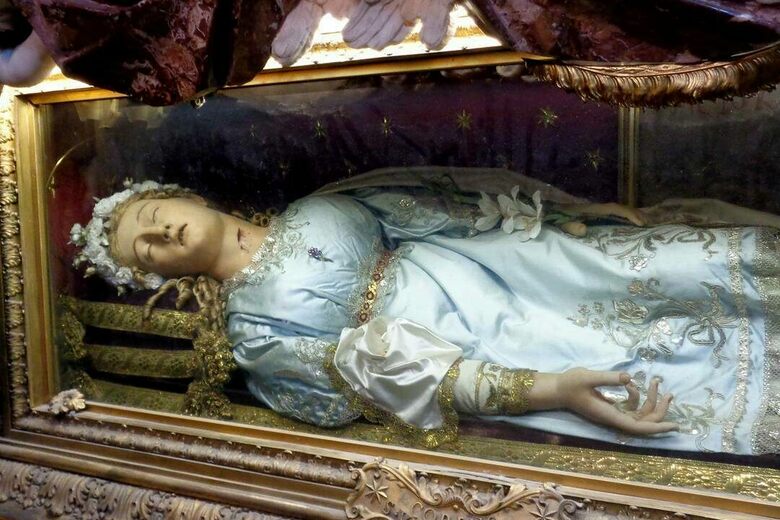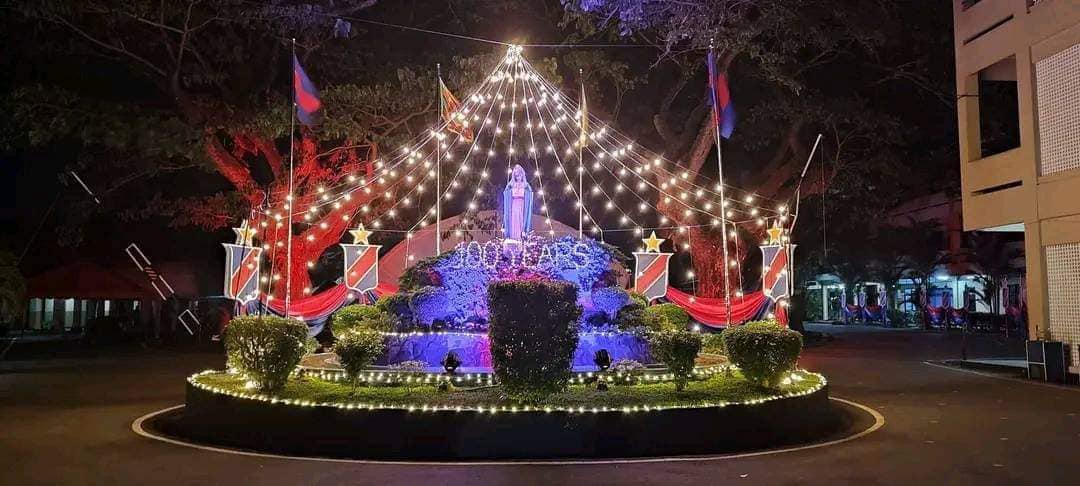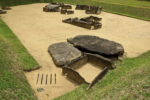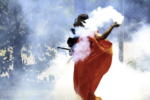TRADITIONAL FIRE-WALKERS OF SRI LANKA
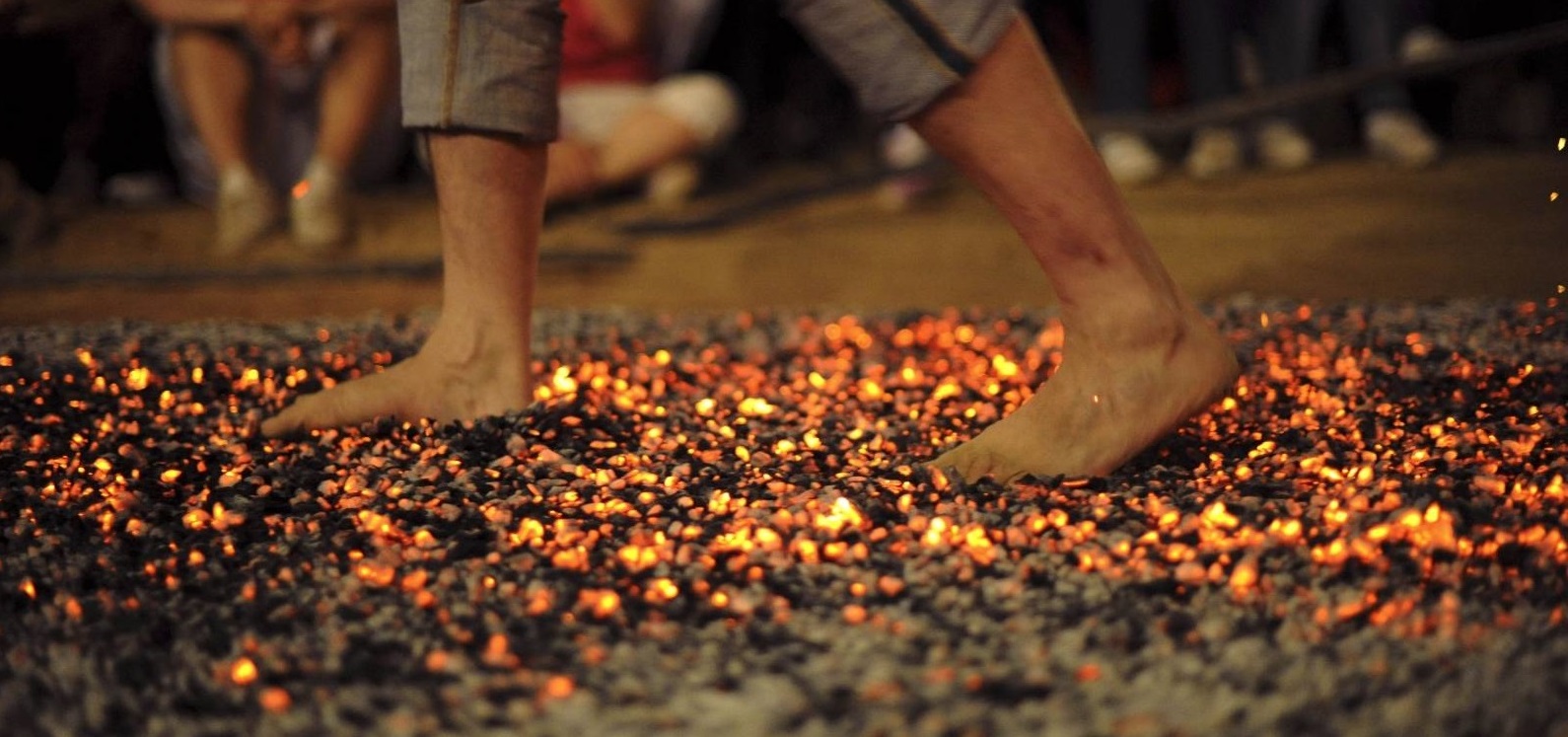
Fire-walking, the act of walking barefoot over a bed of hot embers or stones, is being practised by many cultures across the world with the earliest reference dating back to Iron Age of India (1200 BC). Modern physics says that it has ‘demystified’ the phenomenon, suggesting that a combination of poor conduction of heat and the amount of time the sole of the foot is in contact with the stones, could immunise the people against burns and make them fireproof. Decades back a group of Sri Lankan rationalists, raising a furore in the country, performed this daredevil act to demonstrate that no divine or mystical power is involved in it, but some opponents retorted by saying that the conditions used by the group did not tally with those of the traditional methods of the ritual. However, those who do not favour either theory, assert that there remains a realm of magic and mystery about the whole performance.
Udappu, located 105 km north of Colombo, is a traditional fishing village of Hindu Tamils in the North Western Province of Sri Lanka. This coastal hamlet is bordered on the west by the Indian Ocean, the south by the Andimunai Sand Dunes and the east by the Mundal Lagoon. The city of Chilaw and Munneswaram, an important Hindu temple complex, are located to the south of it.
Udappu, a village of fire-walkers, is the venue of Sri Lanka’s largest festival of fire-walking by Hindu devotees over red hot cinders barefooted, held towards the end of July and early August each year. The festival, lasting for 18 days, attracting many foreign visitors, commences with the flag hoisting and ends with the fire-walking in front of the Draupadi Amman Temple in the village.
Draupadi is a goddess from the Hindu epic Mahabharata and was the wife of the five Pandava brothers in this epic. She is equally believed to be the incarnation of Hindu goddess Kali, goddess of death, time and change.
The villagers, prior to the festival, abstain from liquor and meat, and remain vegetarian. Then they tread on coals burning at over 1500 degrees Celsius, some carrying even their little ones, and go across the embers of wood unscathed. Married women or girls who have reached the age of puberty are not allowed to perform the act.
Mastery over fire among various cultures
‘Fakirs’ (Muslim or Hindu saints or ascetics) of India are master performers of fire-walking before shaky and nervous onlookers. (The word is derived from ‘faqr’, meaning ‘poverty’ in Arabic) They cross the burning trench barefooted and appear at the other end smiling. Some say that the only explanation which seems to be somewhat nearer the truth is that the ‘fakirs’ overcome the pain with their strong willpower. Prior to demonstrating his skills, ‘fakir’ Jatoo Bhai from Calcutta, meditates and prays to the Almighty. When the climax is reached, he dances amidst flames in an attitude of ecstasy. After the dance, spectators find to their surprise that Bhai’s soles are intact with no burns at all. His clothes, remarkably, have not caught fire. In Hinduism the goal of fire-walking is self-realisation and the act is faith-based.
This daring feat, performed annually by the native Indian tribes of North America, assumes a most interesting and baffling aspect. For them, fire-walking is an exercise of purification for which they prepare themselves by building a roaring fire in the ritual hut. The performers then undress themselves and enter the circle of fire with their leader or ‘shaman’. Women often dance around the fire while men go across it. Then the leader takes out the glowing stakes of the wood and applies them on himself and on others. Anyone suffering from burns is considered to be in need of extra prayers. This is followed by each one of them drinking a bowl of salt water which they vomit into a bowl of sand. Anyone, who fails to vomit, is regarded as impure and undergoes the ritual again. Finally, the door of the hut is closed and the ‘shaman’ sits round the fire with his followers until the flames disappear and ashes cool down. The cooled ashes are then mixed with the vomit and left in the open to be blown away.
In the Polynesian islands of the South Pacific, fire-walking is a test of individual strength and courage and a test of one’s faith. For Fijians the feat needs a great deal of preparation. Ten days prior to the celebration, they must segregate themselves from women, thus abstaining from sex, and from eating coconut. Otherwise, according to legend, they would be punished with severe burns. Large river stones are collected and placed in the pit. Eight hours before the ceremony, a log fire is built over the top of the stones to heat them up. Accompanied by dances and chants, ecstasy, or frenzy, the fire-walkers are then led to the arena and they step on the smouldering stones to perform the ritual.
The Shinto-Buddhist fire-walking ceremony, held every year at the foot of the 599 m tall Mt. Takao in Tokyo, Japan, is dedicated to prayers for peace. Fire-walking is also practised in Greece, Spain, China, Tibet, Singapore and Hong Kong.
Christian fire-walkers of Greece and Spain
In some villages in Northern Greece and Southern Bulgaria, a traditional barefooted three-day ritual of fire-walking over glowing wood coals, is held annually, beginning on 21st May and ending on 23rd of the same month. The revellers, carrying the icons of Saints Constantine (306-337 AD), the Roman emperor, and Helena (248-330 AD), the empress and his mother, dance ecstatically for hours prior to entering the fire and emerging unharmed. This unique festival is named Anastenaria in Greek and Nestinarstvo in Bulgarian. The ceremony is repeated, this time indoors, by Eastern Orthodox Christians in January during the festival of St. Athanasius (296-373 AD), a Greek church father, also lasting for three days. The American anthropologist Loring Danforth (born in 1949) at Bates College in Lewiston, Maine, U. S. A., in his book on fire-walking and religious healing, says that the devotees believe that the religious power of St. Constantine allows them to walk across the fiery ovens unhurt and that they consider it a miracle.
San Pedro Manrique, a municipality in central Spain, consisting of smaller villages, is known for its unique celebration of “Día de San Juan” (meaning St. John’s Day in Spanish). On the night of this day, a bonfire is lit next to the shrine of the “Virgin of the Rock” and when it has burnt to embers, the locals remove their shoes and walk barefoot over the dying fire. The festival is thought to be a remnant of a pagan tradition in pre-Christian Spain.
Experiments and explanations
In the 1890s Dr. T. N. Hocken tried to unravel the mystery. He chemically tested the soles of the fire-walkers and also licked them with his tongue, but he was unable to find any foreign protective substance and eventually absolved them of all charges of trickery.
However, English anthropologist Edward Clodd (1840-1930), president of the Folklore Society of England, claimed in 1895 that the entire exercise was a trickery. Clodd, who was sceptical about paranormal phenomena, suggested that the feet of fireproof people may have been rendered insensitive by treating them with sulphuric acid or alum. Even Clodd’s explanations were rebutted. An experiment was conducted in 1937 at Carshalton, England. A fiery pit was prepared and Ahmed Hussain and Reginald Adcock, the two contestants, had their feet thoroughly examined before and after the walk. As the scientists who watched both of them very carefully found that the whole exercise was not fraught with jugglery, they had to accept the unexplained truth that such people may be parading their ‘supernatural’ or ‘unique’ abilities.
Physicist David Willey (born in 1947), and an expert on the science of fire-walking, at the University of Pittsburgh in Pennsylvania, U. S. A., is of the view that people can tread on a trench of burning coals because wood is a lousy conductor. Tolly Burkan (born in 1948 in New York) dismisses the idea by pointing to an incident in which members of his Fire-walking Institute in California successfully walked repeatedly on a heated metal grill without being burned. Burkan argues that what controls the ability to walk on fire is more than physics. “It’s your state of mind”, he says. But Willey denies such ‘mind over matter’ theories, although he agrees that self-confidence is required to take that first step.
Bernard Leikand and William McCarthy wrote in the Skeptical Inquirer in 1985 that fire-walking is possible due to the low thermal capacity of the coals as well as the short time of contact that the fire-walkers’ soles have with the coals.
Fire-walking became popularised in the United States in the 1980s as a technique for overcoming restrictive beliefs and phobias. Some fire-walks are performed in silence while others are accompanied by drumming, clapping or chanting to encourage those crossing the fire. Many have been burned literally, some needing hospitalisation, but others have undergone a rewarding healing experience, even leading to the remission of malignant tumours. Several white men have walked over fire, among them Dr. William Craig (1832-1922), a Scottish surgeon and botanist who made a safe crossing.
John Hyde, a writer and traveller in Japan, observed that the priests, before walking over their herb-strewn fire pits, rubbed the soles of their feet with salt. Hyde did the same and after a walk across the cinders, remarked that in his feet he felt only a sensation of gentle warmth, but his ankles, to which no salt was applied, were scorched.
Meanwhile, in a 2011 scientific study of global interest, the scholars produced evidence of synchronisation between the heartbeats of practitioners and spectators of the fire-walking ritual.
Fire-dancing and fire-eating
Interestingly, fire-dancing and fire-eating traditions exist as well. Egyptian and Algerian dervishes (members of a Muslim religious order who have taken vows of poverty and austerity) have reportedly swallowed hot coals, without causing the least injury to themselves, a practice which has also been reported in Sumatra in western Indonesia. In the late 1800s, a Scotsman named Daniel Douglas Home (1833-1886), was observed to handle hot coals, bathe his face in fire and lie down on a bed of hot coals. Home was a medium who, supposedly, was able to mediate communication between spirits of the dead and living human beings. He was also credited with the incredible ability of levitation to a variety of heights.
Meanwhile, ‘Trial by fire’ was an historic method of proving guilt or innocence. Fire was placed on the skin of the accused, who would not be burned if innocent.
Sri Lankan scholars challenge the feat
The late Prof. Carlo Fonseka (1933-2019) was a Sri Lankan physician, a former president of the Sri Lanka Medical Council and a postgraduate from the University of Edinburgh. He was also a left-wing political activist of the Lanka Samasamaja Party (LSSP), adhering to the Ukrainian-Russian Marxist ideology of Leon Trotsky (1879-1940). Although Fonseka, also a lyricist and a composer, was born to a Roman Catholic family, he became a rationalist and served as a vice president of the Ceylon Rationalist Association. In 1970, along with his members, Fonseka walked over fire, unharmed. Prior to performing the feat, they had consumed liquor and eaten pork in order to prove that neither a vegetarian diet nor other forms of abstinence like fasting were a prerequisite for the ritual. According to him, fire-walking depended on two factors: the thickness of the soles and the duration of contact between the soles and the glowing cinders. Yet, in a letter published in a Sri Lankan English language daily in 1970, Dr. K. Velmany, a Tamil scholar, had observed that the conditions that prevailed at the Kataragama Temple fire-walking in the south of the island and the fire-walking sponsored by the Colombo Medical School were not identical. This temple is dedicated to the Buddhist guardian deity known as Kataragama Deviyo, venerated by Buddhists, Hindus, Muslims and aboriginal Vedda people. The deity is identified with god Skanda, Hindu god of war.
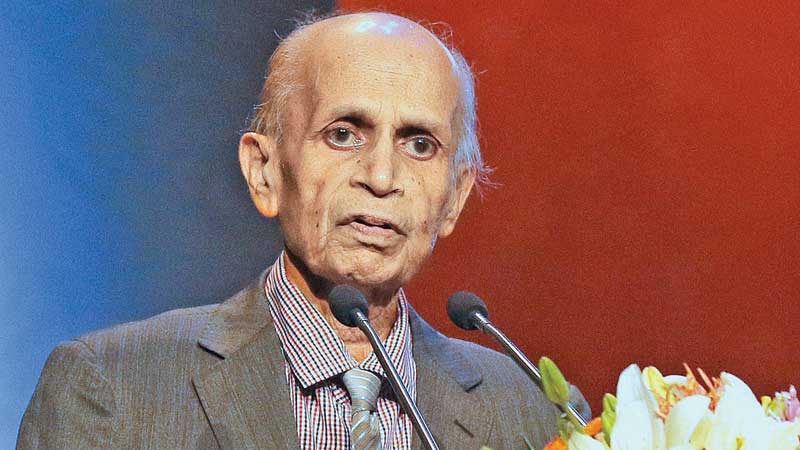
The Ceylon Rationalist Association owes its existence much to the efforts of Dr. Abraham Thomas Kovoor (1898-1978), a Malayali rationalist who had emigrated to Sri Lanka in 1928 from his native Indian state of Kerala. He was the son of a vicar general of the reformed Syrian Church of Malabar. Like Fonseka, he too had embraced rationalism. Having served as a teacher at reputed colleges in northern and southern Sri Lanka and also in Colombo, Kovoor retired in 1959 and devoted most of his time to build up the association and make it vibrant, and he was its president from 1960 until his death. In 1963 Kovoor announced an award of Rs. 100,000 for anyone who could demonstrate supernatural or psychic powers under foolproof and fraud-proof conditions. Fonseka, in 2012, renewed the challenge and increased the reward to one million dollars.
Not only medicine-men, astrologers, palmists, soothsayers, numerologists, necromancers (black magicians), fire-walkers, telepathists (those who read thoughts of others), clairvoyants (those who see distant things beyond normal sensory contact), mediums and séances (communication with the spirits of the dead), poltergeists (known in ghostlore as noisy and mischievous spirits, moving furniture and cutlery and throwing stones, thus tormenting the victims), ghosts and apparitions, charms and talismans, apports (articles that appear from an unknown source during poltergeist activity or séances), etc. but also god-men (babas) of India and even the Bible became the targets of trenchant criticism in Kovoor’s books that were translated into many Indian languages and also into Sinhalese and that became best-sellers. His work, undoubtedly, must be commended for exposing charlatans and hoaxers who deceive gullible or credulous people for money or cheap publicity, but at the same time others have been critical of the methodology he used in his investigations. They claim that Kovoor tailored his experiments to fit his own “preconceived” notions or beliefs which they say sounds “biased” and “unscientific”.
Science accepts a fact as genuine and valid as long as it can be proven in a laboratory repeatedly, producing the same result. But, in the case of paranormal phenomena, this is not so and they are capricious: unreliable and unpredictable and therefore, discouraging to many researchers. Can this be a point for disproving the phenomena outright?
Science has made great strides in the recent past, making newest discoveries, particularly in the field of “quantum physics”. Such findings are shaking the very basis of materialists and are leading many orthodox and eminent scientists to doubt or change the views and opinions that they have held so far and that they have considered “sacrosanct”.
“We have now been able to prove, by purely scientific analysis, the existence of an invisible and immaterial world. This result is the fruit of twenty-seven years of research into gravitational waves”, says Dr. A. J. Glazewski, an American scientist of Polish extraction. ***
